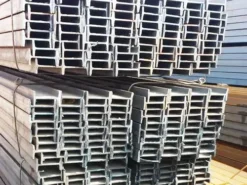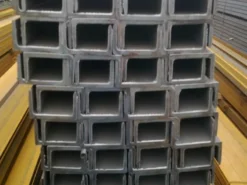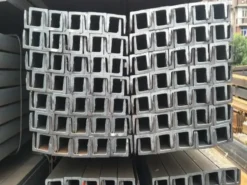Angle steel is a carbon structural steel used in construction. It is a simple cross-section steel material. It is mainly used for metal components and factory building frames. It requires good weldability, plastic deformation performance and certain mechanical strength during use. The raw material billet for the production of angle steel is low carbon square steel billet, and the finished angle steel is delivered in a hot-rolled, normalized or hot-rolled state.
Angle steel, commonly known as angle iron, is a long strip of steel with two sides perpendicular to each other. There are equilateral angle steel and unequal angle steel. The width of both sides of the equilateral angle steel is equal. Its specifications are expressed in millimeters of side width × side width × side thickness. For example, “∟30×30×3” means an equilateral angle steel with a side width of 30 mm and a side thickness of 3 mm. It can also be expressed by model number, which is the number of centimeters of side width, such as ∟3#. The model number does not indicate the dimensions of different side thicknesses in the same model. Therefore, the side width and side thickness dimensions of the angle steel should be filled in completely on the contract and other documents to avoid using the model number alone. The specifications of hot-rolled equilateral angle steel are 2#-20#. Angle steel can be composed of various stress-bearing components according to different needs of the structure, and can also be used as a connector between components. It is widely used in various building structures and engineering structures, such as roof beams, bridges, transmission towers, lifting and transportation machinery, ships, industrial furnaces, reaction towers, container racks and warehouses.
-Chemical Composition:
(1) Composition index: The chemical composition of angle steel belongs to the general structural rolled steel series, and the main verification indexes are C, Mn, P, and S. The content varies depending on the brand. The general range is C<0.22%, Mn: 0.30-0.65%, P<0.060%, S<0.060%.
(2) Inspection methods: When testing the above chemical components, commonly used standard inspection methods include GB223, JISG1211-1215, BS1837, BS Manual 19, ГОСТ22536, etc.
-Weight calculation:
Weight per meter =0.00785*(side width+side width-side thickness)*side thickness
-Grid standard:
GB/T2101-89 (General provisions for acceptance, packaging, marking and quality certificates of section steel); GB9787-88/GB9788-88 (size, shape, weight and allowable deviation of hot-rolled equilateral/unequal angle steel); JISG3192- 94 (shape, size, weight and tolerance of hot-rolled steel); DIN17100-80 (quality standard for ordinary structural steel); ГОСТ535-88 (technical conditions for ordinary carbon steel).
According to the provisions of the above standards, angle steel should be delivered in bundles, and the number of bundling passes and bundle length should comply with the regulations. Angle steel is generally delivered naked, and moisture-proofing is required during transportation and storage.
-Equilateral angle steel specifications and models:
2.5#: 25*25*3=1.124kg/m, 25*25*4=1.459kg/m
3#: 30*30*3=1.373kg/m, 30*30*4=1.786kg/m
4#: 40*40*3=1.852kg/m, 40*40*4=2.422kg/m, 40*40*5=2.976kg/m
5#: 50*50*4=3.059kg/m, 50*50*5=3.77kg/m, 50*50*6=4.465kg/m,
6#: 60*60*5=4.57kg/m, 60*60*6=5.42kg/m
7#: 70*70*5=5.397kg/m, 70*70*6=6.406kg/m,70*70*8=8.373kg/m
7.5#: 75*75*5=5.818kg/m, 75*75*6=6.905kg/m, 75*75*7=7.976kg/m
8#: 80*80*6=7.376kg/m, 80*80*8=9.658kg/m, 80*80*10=11.874kg/m
9#: 90*90*8=10.946kg/m, 90*90*10=13.476kg/m, 90*90*12=15.94kg/m
10#: 100*100*6=9.366kg/m, 100*100*8=12.276kg/m, 100*100*10=15.12kg/m, 100*100*12=17.898kg/m
-Unequal Angle Steel:
Q235B: 56*36*4, 63*40*5, 75*50*6, 100*63*6*9m, 125*80*10*9m, 110*70*8*9m, 160*100*10*9m…
-Mechanical behavior:
(1) Inspection method:
① Tensile test method. Commonly used standard inspection methods include GB/T228-87, JISZ2201, JISZ2241, ASTMA370, ГОСТ1497, BS18, DIN50145, etc.; ② Bending test method. Commonly used standard inspection methods include GB/T232-88, JISZ2204, JISZ2248, ASTME290, ГОСТ14019, DIN50111, etc.
(2) Performance indicators: The inspection items to evaluate the performance of angle steel are mainly tensile test and bending test. Indicators include yield point, tensile strength, elongation and bending qualification.











